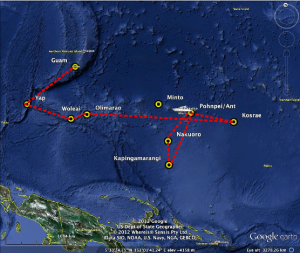Falalis Forever!
Of all the wonderful things we've seen and done so far on this trip, one of the most memorable was our visit to the island of Falalis in Woleai Atoll. When we arrived at Woleai, we first went to meet the village elders to ask their permission to study the coral reefs. The information they shared helped ensure the success of the expedition, and when we left that morning, Fabian our translator asked us to return and tell the people what we had found. We came back the following afternoon and sat down at what I call the council circle, where we were welcomed as friends and offered coconut shells filled with tuba, a ceremonial drink made of palm sap. I described some of our findings - Fabian translated for the elders and other fishermen, and translated their questions back to us. He said they were concerned that there weren't as many clams as there used to be. Fabian then looked serious and said "We're going to be chased away". I said "How? By who?" He winked and said "That rain storm right there." Sure enough, it started raining within seconds and we all ran under the cover of the men's meeting lodge. Normally, women aren't allowed in the men's meeting areas, but Fabian said the women in our group were scientists, and "that was different." While we were in the lodge, many of the elders asked questions about climate change, and said they were concerned about what would happen to them if sea level started to rise. They had nowhere they could go, and wanted our advice on what to do. I told them because of the physics of greenhouse gases, global warming was likely to continue before we can start to make it better, and that they needed to prepare rather than hope it might not yet happen. They said they have noticed parts of the island eroding already, and that they needed supplies to help raise their homes off the ground. They were sincerely thankful that we had come to study their reefs and gave me a beautiful cloth sarong as a gift, saying that they hoped we would come back again to continue our studies. I hope we do!
We were invited to go for a tour of the village, and we all were eager to see their homes and how they lived. [see the slide show on the left to follow along] They can climb up 50 foot tall coconut trees in a flash, using the footholds carved in the trunks. Their homes are covered with thatch from palm fronds, and some have plywood for the lower walls. We met some of the women, who were weaving small baskets out of palm leaves to hold balls of breadfruit. They bury the breadfruit balls in the ground for up to six months until they become ready to eat! Their fishing boats are elegant outrigger canoes that they carve themselves, and the men meet at the council circle each night to hear the elders decide how they will all fish the next day. Sometimes with hook and lines, sometimes with nets, and sometimes spearfishing. All the men fish and all of the fish are divided communally among the entire village. Nearly everyone we saw was smiling and happy, especially the kids who shrieked and laughed, pretending to be shy and then playing games with us as we walked on the beach. Before we left, we returned to the council circle. They offered us more tuba to drink and bananas and coconuts for the ship, and we told stories and laughed until it was time to go. I felt like we had been welcomed into their society openly and sincerely, and as we left it was like saying goodbye to good friends. Steven our guide said they love their island and enjoy living there. They have a saying in the village - "Falalis Forever!" - and I couldn't possible agree more!



0 comments:
Post a Comment